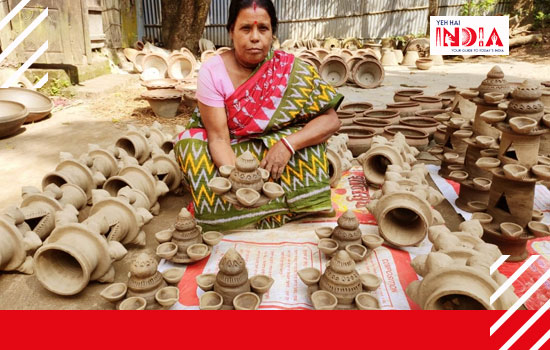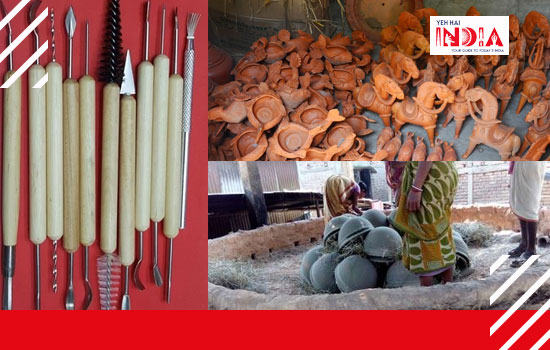Indian heritage has a unique distinction of identifying its art forms as ‘a medium of expression’.
Each art form as a cultural legacy and history that identifies with several forms of expressions.
Terracotta is regarded as one of the oldest medium of expressions in Indian culture.
The ‘Asharikandi’ village of Dhubri district in Assam is the largest cluster in entire India where pottery and terracotta are produced.
This craft has socio-cultural characteristics inspired from past traditions, lifestyles, beliefs, and rituals, that date back to Harappan and Indus Valley civilization.
Here is the story of this amazing craft and craftsmen!
Recommended Story – Ajrakh – Craft Created in Harmony with the Nature
Asharikandi – India’s Terracotta Village

Terracotta is one of the oldest crafts that humans ever introduced on this earth.
It is an object of art made of special compositions of clay and sand and is baked with earthen color which turns it into brownish red.
Asharikandi, located 14km away from the town of Dhubri in Assam has a small cluster of male and female of nearly eighty families who are preserving this heritage and carrying out its legacy.
It is the primary source of income to these communities and the tradition is handed down from generation to generation.
The village shares both inter-state and international borders with West Bengal, Meghalaya, and Bangladesh.
Meaning

The term ‘Asharikandi’ is derived from two words, ‘ASHAR’ and ‘KANDI’.
Ashar is the third month in the Assamese calendar and Kandi refers to ‘shedding tears.’
Weather is an important attribute of this village.
During the Ashar, heavy rainfalls cause floods in these low-lying areas.
The dwellers of this place shed tears out of havoc caused by floods.
Nevertheless, the monsoons make the soil damp and moist. This soil is then used for making the terracotta.
Communities and Families

The present pottery profession in the cluster is practiced by kumaras and Hiras, who belonged to the Namasudra community.
The terracotta toys are also made by fisher folks, usually toys and house decoratives.
At present, the pottery in Asharikandi is practiced by households of five villages: Palpara, Baganpara, Bogurapara Madikhali, and Sikhasipara.
The villages contain more than 200 households covering around 800 craftsmen.
Asharikandi is also popularly known as paul padi, the caste of these traditional artisans.
History

Asharikandi is 2500km east to what was once the great civilization of Harappa.
The tradition is said to have travelled east from the Sindh province, and an unbroken thread of connection is believed to have settled in present Bangladesh and North-East India.
The practice of modern terracotta of Asharikandi dates to more than 100 years.
These communities had migrated from the Pabna District (present Bangladesh) to Asharikandi during the British Era.
Earlier, the communities used to supply their products to the Zamindari families of Gauripur and were primary sources of wares and utensils over a significant period.
The Gauripur royal family also used to nurture elephant centered culture during the British era.
Many locals were involved in several businesses that depicted elephants. The roots of this tradition are deeply nurtured through Gauripur royals.
Usage, Production, and Sales

Asharikandi is surrounded by river Godadhar, a tributary of the mighty Brahmaputra.
Nestled away from the hustle of cities, this place gives advantage for marketing network with major cities in the North East.
The raw materials, primarily clay (Hira mati or aithal mati) and sand, required for making terracotta is procured from the river side of Silaipur, located about 18-20km away from Asharikandi.
A few years back, terracotta and pottery were part time jobs of these villagers. At present, the work is main profession for many families.
The primary products include pitchers, utensils, and pots.
Terracotta products like Hatima Doll, Ainar Horse, Elephant, and Rhino are popular among animals and make wide sales.
Idols of gods and goddesses, houses, house decorative items also make good sales in the market.
The products are now transported across India with the co-operation of welfare societies and NGOs.
Govt. Departments and NGOs also organize exhibitions and trade fairs where sellers of terracotta and pottery items come to artisan cottages and purchase products directly from the village.
Recommended Story – Leather Crafts of India
Tools, Production, and Design

The process of terracotta making is very long and labour intensive. It involves hard labour time along with working weather conditions.
Traditional tools and articles used by the artisans include kodal, kaim, knives, boila, pitna, and brushes.
- Kodal or spade is used for cutting the clay in the initial stage.
- Khota is a thin tool, made of bamboo that is used to remove the impurities of soil.
- Boila and pitna are essential to give the desired shape of the clay.
After procuring the clay from the riverbanks, it is soaked for nearly four hours or sometimes, overnight.
In the next step, impurities are manually removed with the use of tools.
The composition is put under the sun for several hours and then kneaded with hands and feet to obtain the elasticity. This process involves nearly 2-3-hour continuous labor.
Raw clay is then mixed with water, sand, and caustic soda to avoid breaks cracks and bends.
After processing the clay, depending on the type and shape of the object to be made, various means are used to create the products.
Cylindrical pottery is made on wheels. Coiling and pinching are used to make other kind of shapes.
Lastly, the finished products are exposed open to the sun for one or two days and then quoted with kabish.
‘Kabish’ is a powder prepared from sands collected from the nearby foothills.
Finally, the objects are baked in the traditional kiln in medium temperature.
Journey and the Challenges

Despite lacking opportunities, the communities have endeavored for the past 5-6 decades to find a better market and create consistent growth.
A recent study titled ‘Economic Survey on Terracotta, Tourism and Trade’ undertaken by the North East Craft and Rural development Organization (NECARDO), an NGO that works for the welfare of artisans in Dhubri has made a survey on the journey of these craftsmen.
The result of this survey is amazing. At present, the annual turnover of these pottery business is around 12 crores (1,87,5000 $).
In the past 10 years, the families have made a hard route to earn their livelihood.
It is said that in the early 2005- 2010, the community barely got any returns.
From mere INR 200-300 per month, the earning per family now varies from INR 60,000 – 2.5 Lakh.
The multifarious significance of this socio-cultural dimension is this preserved and protected.
Also Read – Ivory Handicrafts in India











Very good and extensive research, I wish more such real artisans be brought directly into notice and your website benefit them by directly promoting their products and may be selling them through the wonderful platform that you have created.
Very informative. Loved this article